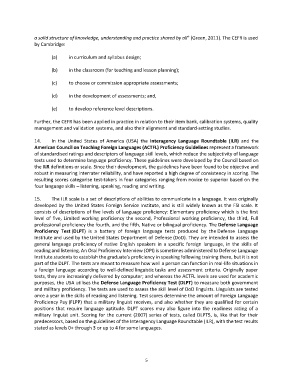Page 1478 - SUBSEC October 2017_Neat
P. 1478
a solid structure of knowledge, understanding and practice shared by all” (Green, 2011). The CEFR is used
by Cambridge:
(a) in curriculum and syllabus design;
(b) in the classroom (for teaching and lesson planning);
(c) to choose or commission appropriate assessments;
(d) in the development of assessments; and,
(e) to develop reference level descriptions.
Further, the CEFR has been applied in practice in relation to their item bank, calibration systems, quality
management and validation systems, and also their alignment and standard-setting studies.
14. In the United States of America (USA) the Interagency Language Roundtable (ILR) and the
American Council on Teaching Foreign Languages (ACTFL) Proficiency Guidelines represent a framework
of standardised ratings and descriptors of language skill levels, which reduce the subjectivity of language
tests used to determine language proficiency. These guidelines were developed by the Council based on
the ILR definitions or scale. Since their development, the guidelines have been found to be objective and
robust in measuring interrater reliability, and have reported a high degree of consistency in scoring. The
resulting scores categorise test-takers in four categories ranging from novice to superior based on the
four language skills – listening, speaking, reading and writing.
15. The ILR scale is a set of descriptions of abilities to communicate in a language. It was originally
developed by the United States Foreign Service Institute, and is still widely known as the FSI scale. It
consists of descriptions of five levels of language proficiency: Elementary proficiency which is the first
level of five, Limited working proficiency the second, Professional working proficiency, the third, Full
professional proficiency the fourth, and the fifth, Native or bilingual proficiency. The Defense Language
Proficiency Test (DLPT) is a battery of foreign language tests produced by the Defense Language
Institute and used by the United States Department of Defense (DoD). They are intended to assess the
general language proficiency of native English speakers in a specific foreign language, in the skills of
reading and listening. An Oral Proficiency Interview (OPI) is sometimes administered to Defense Language
Institute students to establish the graduate's proficiency in speaking following training there, but it is not
part of the DLPT. The tests are meant to measure how well a person can function in real-life situations in
a foreign language according to well-defined linguistic tasks and assessment criteria. Originally paper
tests, they are increasingly delivered by computer; and whereas the ACTFL levels are used for academic
purposes, the USA utilises the Defense Language Proficiency Test (DLPT) to measure both government
and military proficiency. The tests are used to assess the skill level of DoD linguists. Linguists are tested
once a year in the skills of reading and listening. Test scores determine the amount of Foreign Language
Proficiency Pay (FLPP) that a military linguist receives, and also whether they are qualified for certain
positions that require language aptitude. DLPT scores may also figure into the readiness rating of a
military linguist unit. Scoring for the current (2007) series of tests, called DLPT5, is, like that for their
predecessors, based on the guidelines of the Interagency Language Roundtable (ILR), with the test results
stated as levels 0+ through 3 or up to 4 for some languages.
5

